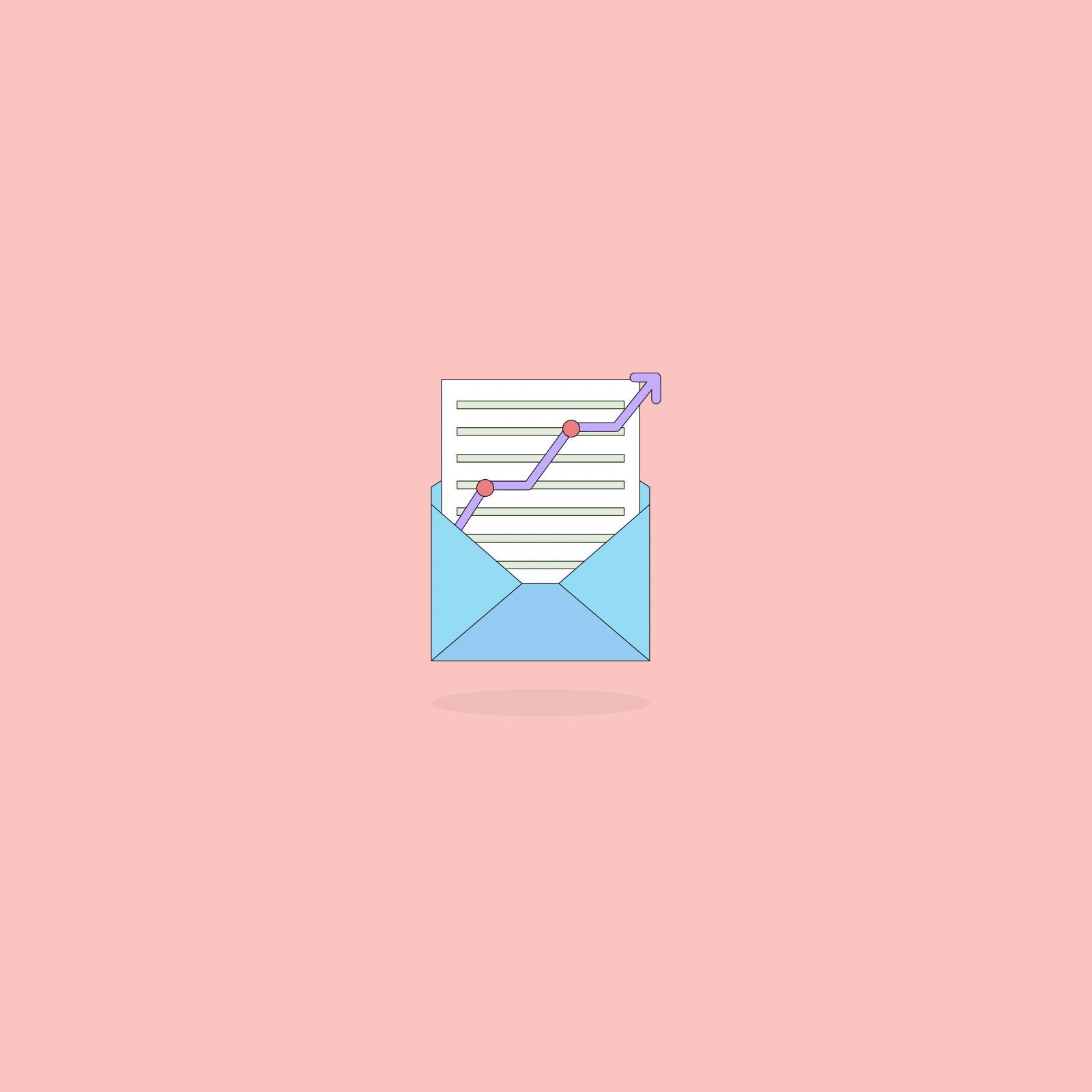Our websites use cookies. By continuing, we assume your permission to deploy cookies as detailed in our Privacy Policy.
Personalised Emails: Benefits and Examples
With innumerable promotional emails vying for your audience’s attention, how do you ensure that your message not only gets noticed but also sparks genuine interest?
The answer lies in email personalisation.
Tailoring your emails to your audience is absolutely essential for achieving outstanding results in your email marketing efforts. It’s vital to ensure that your emails strike a chord with your readers to maximise their impact and precision.
This article will unravel the benefits of personalised emails, share real-world email marketing campaigns by renowned brands and explain why they work.
Key Takeaways
- Generic emails are passé. Craft campaigns that treat each subscriber as a unique individual, addressing their preferences and behaviours.
- Whether you’re starting small or aiming big, personalised emails can be tailored to suit your brand’s goals and customer expectations.
- Personalised communication isn’t just about immediate gains. It’s a way to build lasting relationships and foster brand loyalty.
What’s a Personalised Email?
A personalised email is a targeted marketing communication sent to an individual tailored to their preferences, behaviours, and characteristics.
Instead of sending the same generic message to a broad audience, personalised emails leverage data to create and deliver content that resonates with recipients on a personal level.
Download: Personalised Email Marketing Playbook
5 Benefits of Personalised Emails
Without much further ado, let’s dive in and examine the benefits of personalised emails:
1. Cost-Effectiveness
Crafting personalised emails might seem resource-intensive at first glance, but the returns on investment (ROI) can far outweigh the costs. Compared to traditional mass emails, where a one-size-fits-all approach is taken, personalised emails yield higher conversion rates, making them a cost-effective choice in the long run.
To increase your reach, investing in this field will help you reach more people, such as email services that will help you build your email list for a fee. With this investment, it is important to keep your ROI in mind as there are better strategies than investing in this heavily to start with. However, in the long run, having a targeted email list will go a long way in converting contacts to sales.
2. Higher Open Rates
Many people who receive brand marketing emails in their inboxes say they delete them without opening them. People say they treat the “Promotions” folder in their Gmail accounts as spam and will not open any email stored under it.
So, what can you do to improve your open rates?
Is it as simple as putting “Dear [First Name]” in the subject lines? While this strategy can boost your open rates by around 40%, more steps should be taken to increase the open rates with further personalisation.
In addition to personalising the subject line, it is essential to make the subject line give information about the email’s content.
Touching base on your customer’s activity on your website is essential in this regard. For example, a subject line that says “Dear [NAME], you might be interested in leopard print handbags.” will ensure that you are addressing the right person and their interests regarding their shopping behaviour.
Recommended reading: Email Subject Line A/B Testing Best Practices
The biggest takeaway is that when an email resonates with the recipient, they are more likely to open it. By tailoring the subject line and content to suit the individual’s preferences and needs, personalised emails can experience notably higher open rates.
3. Improved Click-Through Rates
A benchmark by Bluecore on emails reports a 139% increase in click-through rate (CTR) for personalised emails. In addition, repeat customers are more likely to continue shopping, while converting first-time buyers is more complicated.
This benchmark shows us that personalised email content is a must if you want to increase your CTR. This increase in CTR can only be achieved by accurate content and product recommendations in the email’s content.
Platforms such as Segmentify, where AI engines directly process the users’ website activity to display the products or content they are more likely to be interested in, help create the ultimate personalised email communication.
An example of the case is the most prominent in price-drop products. When customers go through your catalogue, they most likely see the prices, note the products they are interested in, and wait for the price to be more affordable for their budget.
An email that includes these products both in the content and the subject line of the email means that these customers you have not converted before will open the email, see the products they saved and click on them as they are on discount. This will help massively with the CTR and ensure that the visitor is converted into a customer.
4. Increased Conversion Rates
Building a personalised network of emails means that your customers will start to create a bond with your brand as they will notice that everything you are sending over is personalised to their liking. This means that your emails will stand out from the crowd when it comes to being personal to one customer, accurate to their preferences, and showing them what they might be interested in.
As mentioned before, having the right personalisation tool that will do all of this for you without any effort means that you will be converting more people into customers who might not even have bought a single product from you before, as well as keep customers coming back for more in the long run.
A person who sees a cookie-cutter email you send them might need to click on the products in it. However, a person that is sent an email that shows them what they were or are still interested in will capture their attention. This attention-grabbing email, in turn, will bring the customer back to the store and get them a step closer to a purchase.
In an email, try to show a person interested in baggy clothing, skinny jeans. You will not only ensure they will not get back on the website, but they will also ignore future emails, which show the importance of accurate customer profiling and targeted advertisement in capturing and keeping customers.
5. Better Return On Investment (ROI)
The combination of increased open, click-through and conversion rates results in an improved ROI. When your marketing pounds are invested in reaching the right people with the right message, the returns become substantially more attractive.
As email marketing is expected to reach a revenue of $11 billion by the end of 2023, the piece of the pie you will have can either be small or large depending on your choosing the strategy, the amount of investment into email marketing, and the 3rd party tools.
With the right strategy, you ensure you get a more significant piece of the pie and build a better relationship with your users. This strategy should focus on how much you’re investing in the tools regarding money and time and how much revenue they bring to your company. With the right strategy, tools, and tests, your email marketing ROI can be as high as 28%.
Personalised Email Examples to Inspire You
1. Abandoned Cart Email – Adidas
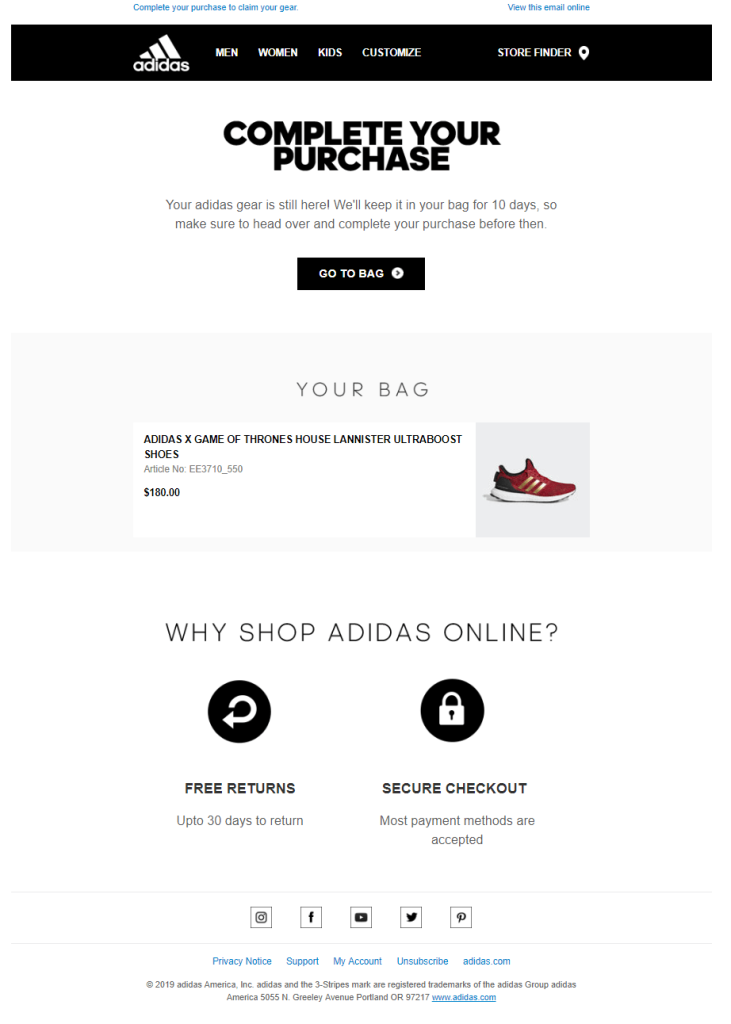
Why personalised emails like this work: In this particular example, Adidas reminds the customer about the item they left in the cart. The elements that make this cart abandonment email hit the bull’s eye are:
- Sense of urgency: It’s explicitly communicated that the item will be available for only ten days.
- UX optimisation: The “Go to Bag” button takes the customer directly to the cart.
- Mobile-optimised design: The aforementioned “Go to Bag” button is placed above the fold to avoid scrolling down on a mobile device. The button is a dark colour, creating a contrast between itself and the general design, and it doesn’t have any clutter around it, making it easier to click on.
- Reassures the customers: The free return policy and payment method selection is presented in an easy-to-read way.
2. Birthday Email – Nintendo
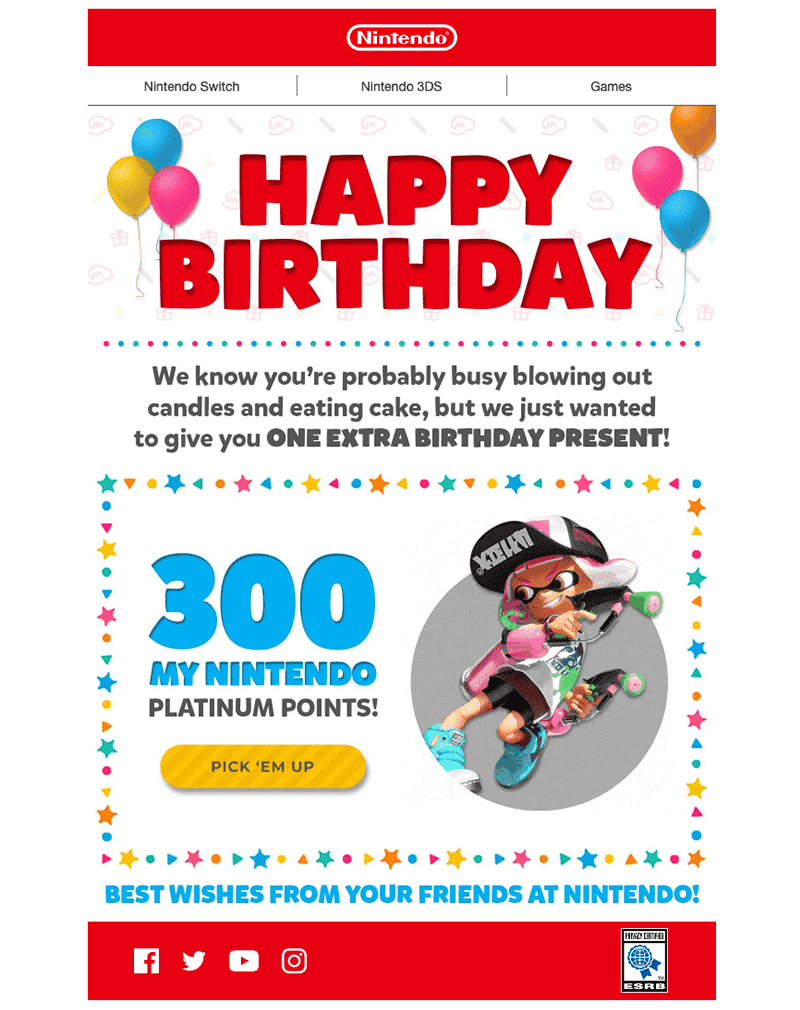
Why personalised emails like this work: Nintendo celebrates its customer’s birthdays by granting them loyalty points, which they can use with future purchases.
- Design: The email’s design elements and colour choices reflect the brand’s vibrant personality.
- Email copy: Like the design, the email copy matches Nintendo’s childlike, playful tone.
- Loyalty points: Who doesn’t like free points they can use for their next purchase, especially if you’re somewhat of a regular customer?
3. Instructional Email – Holafly
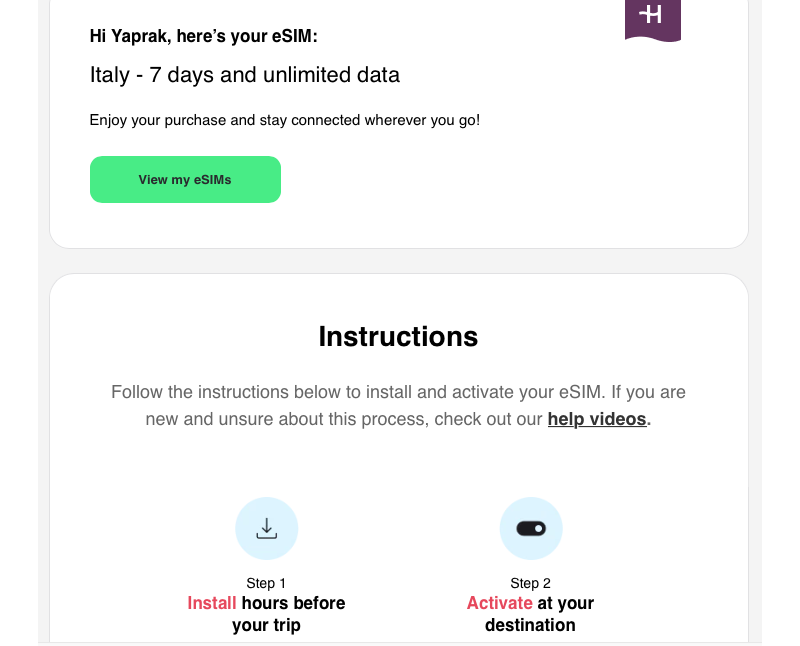
Why personalised emails like this work: The eSIM card provider Holafly sends its customers instructional emails explaining how to install and activate their eSIM after finalising their purchases. The email content includes:
- Product purchase details: Destination country, travel duration, and data amount are listed.
- Detailed instructions for different devices: If you have to go and look for the information rather than it being presented to you in an easy-to-follow manner, you will not choose that service provider the next time you need a similar service.
4. Transactional Email – Airbnb
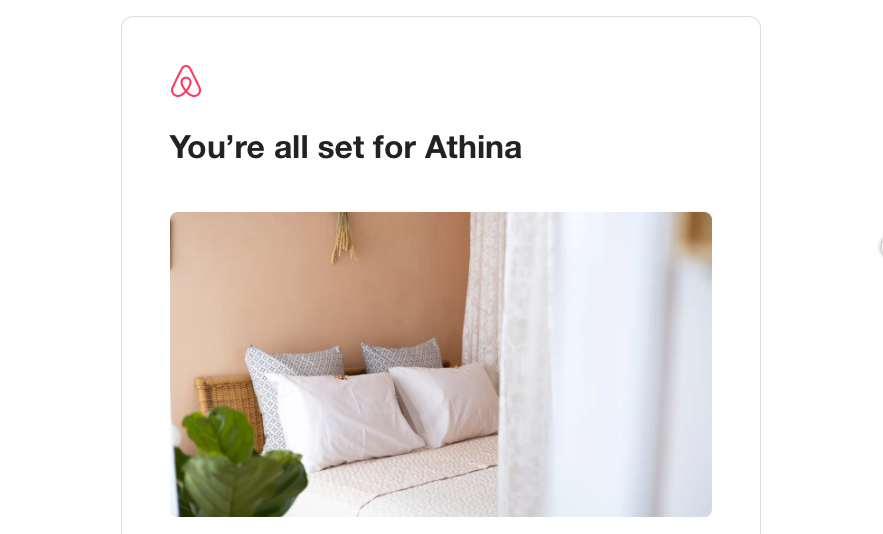
Why personalised emails like this work: Order or reservation confirmation emails like the one Airbnb sends are crucial for brand-customer relationships. Because 1) customers want reassurance that the transaction was successful and 2) they want the useful information right under their fingertips.
- Design: The email design is sleek and free of any clutters to let what is truly important shine—information.
- Reservation details: Booking dates, costs, location, and host information are listed.
- Cancellation policy: Airbnb reminds the customer of their host’s cancellation policy should they need it.
5. Welcome Email – Nespresso
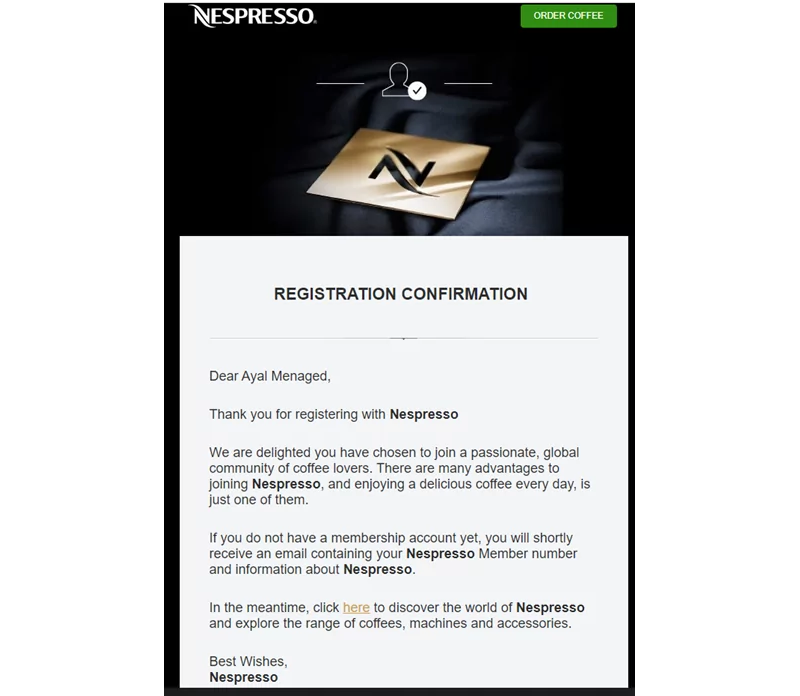
Why personalised emails like this work: Nespresso’s welcome email is one for the books; it looks and feels like you’ve got an invitation from an exclusive club.
- Design: The email’s sleek design matches Nespresso’s visual language perfectly.
- Call-to-action: The CTA button sits at the top right corner and is pretty easy to spot.
- Focusing on relationship building: This welcome email isn’t about getting that cash right away. Nespresso first wants the subscriber to discover their product range, emphasising the main message—they’re delighted to have the subscriber there.
Final Words on Personalised Emails
Generic, one-size-fits-all emails are a thing of the past. Your subscribers crave content that resonates with their individual preferences and needs.
Building a strong relationship between a brand and its audience requires meaningful interactions. Personalised emails offer a direct way to achieve this goal. Using data, technology, and creativity, you can cultivate connections beyond the screen.
To achieve positive outcomes, you must extend email personalisation beyond simply incorporating the user’s first name. True email personalisation involves:
- Personalising content for various time zones.
- Catering to the desires and requirements of users.
- Incorporating visual elements.
FAQs About Personalised Emails
What is email personalisation?
Email personalisation refers to tailoring email content to match the individual recipients’ characteristics, preferences, behaviours, and interactions with your brand. Personalised communications go beyond basic elements like addressing recipients by name and include subject lines, body content, offers, and CTAs.
What are the benefits of personalised emails?
Personalised emails offer several benefits, including:
- Cost-effectiveness
- Higher open rates
- Higher click-through rates
- Higher conversion rates
- Higher ROI
Are personalised emails more effective?
Yes, personalised emails are generally more effective than generic mass emails. Personalisation makes your brand’s communication more relevant and engaging for recipients by tailoring content to their interests, needs, and behaviours.
How much does it cost to set up personalised emails?
Personalised emails can elevate engagement levels and provide an enhanced user experience, making the additional effort unquestionably worthwhile.
What elements in an email can you personalise?
You can personalise these elements in your email marketing:
- From name
- Subject line
- Email copy
- Multimedia
- Email content offers
- Product/content recommendations
Editor’s Note: This article was originally published on December 13, 2021, and was updated for accuracy and comprehensiveness on August 23, 2023.



